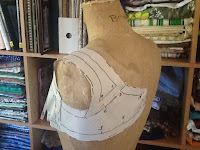I need a new dress for the 2013 Charleston Challenge in the Blue Mountains, on the 3rd February. Now 20s fashion isn't my style, I'm a woman with hips and bust and the tube style does tend to make me look rather solid! However, I found this dress on Vintage Textiles through a Google search ...
... and then Koshka the Cat's interpretation further down the same search. I was inspired by the design and decided to give it a try with some changes. The thing I like about this gown is that it does have a fitted waist and I love the gathering for the bust darts on the bodice. Its heading into the 30s and the elements that will change the style completely to bias cut fitted gowns.
I have an original 1920s pattern that would give me the base for gown, its a New Deltor Butterick pattern 2347.
I cut out the base dress, I used a blue and white pin stripe cotton for the bodice and a navy blue cotton for the skirt, both soft to the hand so they would drape well. I was trying to give a 'separates' feel, yes, as you see, I am already diverging from the style. It also means that I have completed my Challenge #6 Stripes for the HSF!
I draped a shawl sleeve/collar in the dark blue.
Then I took a further turn to the left ... I decided to leave the ruffles off! When I put the bias onto the shawl sleeves/collar I felt the whole outfit was 'busy enough' and ruffles weren't required.
I like the look of this dress, no its not a copy of an extant gown, but it does have the 20's feel that I wanted. It will be worn next Saturday for the Charleston Challenge in Leura. More photos of that event after we played!
Historical Sew Fortnightly
The Challenge: #6: Stripes - due March 25. The stripe is one of the
oldest patterns, appearing in the earliest textile fragments and visual
records of garments, and its never gone out of style since. Celebrate
stripes with a striped garment. Will you go for grand baroque stripes,
pastel rococo stripes, severe neoclassical stripes, elaborately pleated
and bustled Victorian stripes, or something else entirely?
- Fabric: Cotton seer sucker blue and white stripes for the bodice and binding, dark blue cotton, both
from my stash - Pattern: New Deltor Butterick pattern 2347 and pattern draping.
- Year: 1920s no date on pattern and can't locate it on the interwebs so far.
- Notions: Thread, sewing machine.
- How historically accurate is it: Not too bad, the base dress is based exactly on the original pattern, the shawl sleeves/collar on the original 1929 dress from Vintage Textiles
- Hours to complete: 8 solid hours, done over a few days.
- First worn: 3rd February for the Roaring Twenties Charleston Challenge in Leura Mall in the blue Mountains, 2013
- Total cost: None except my time, everything came from my stash.
I'm The Tailor's Apprentice and I have created The Miss Page Vintage Pattern Collection. 1940s WWII dress making patterns for the 21st century woman. Patterns created by me from my extant 1940s gowns. All my patterns are available on Etsy and my website where you'll find out more about me as well. This year I am publishing an 1820s gown wardrobe pattern.
























